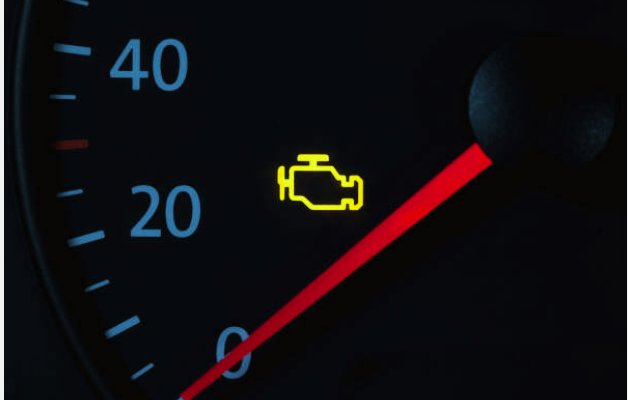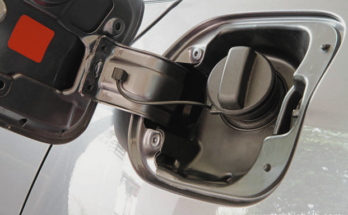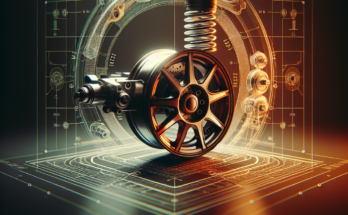The check engine light is one of the most dreaded warning signs that can appear on a car’s dashboard. It can cause panic and anxiety for drivers who associate it with costly repairs. However, understanding what the check engine light means and how to respond to it can alleviate some of the stress. In this post, we’ll look at the top causes of check engine lights and what you can do about them.
Key Highlights
- The check engine light is a warning sign that indicates a malfunction in the vehicle’s systems.
- It is important not to ignore the check engine light, as it can indicate both minor and serious issues.
- Diagnosing the cause of the check engine light requires a diagnostic test using an OBD-II scanner.
- Check engine lights can be triggered by a number of things, such as an oxygen sensor issue, a catalytic converter issue, or a spark plug issue.
- Taking immediate action when the check engine light comes on can help prevent further damage to the vehicle.
- Regular maintenance and preventive measures can help avoid check engine light issues in the future.
What is a Check Engine Light?
The check engine light-also known as the malfunction indicator lamp(MIL) – It serves as an alert from the car’s engine control unit, indicating a variety of issues that may impact engine performance. Unlike other dashboard lights, the check engine light signifies engine problems that require immediate attention. When this warning light appears, it is essential to conduct a diagnostic test to identify the trouble code.
Understanding the check engine light and responding promptly can prevent costly repairs and maintain the vehicle’s optimal condition. Ignoring this warning may lead to severe engine damage over time. Paying heed to the check engine light can save you from being stranded on the side of the road with a malfunctioning vehicle.
Depending on the manufacturer, check engine lights can come in different colors, such as orange, yellow, or amber. However, if the check engine light starts flashing, it’s a sign of a more serious issue, like a misfire, which can overheat your catalytic converter in a matter of seconds. Check engine lights are emissions devices that operate at high temperatures to reduce emissions.
Common Reasons for the Check Engine Light to Activate
- Oxygen Sensor Malfunctions: Oxygen Sensor sensor plays a crucial role in monitoring the amount of oxygen in the exhaust gases and helps regulate fuel efficiency. When the oxygen sensor malfunctions, it can provide inaccurate readings to the engine control unit, leading to decreased gas mileage and reduced engine performance. A diagnostic test using an OBD-II scanner can help identify the specific problem with the oxygen sensor and guide the necessary repairs.
- Catalytic Converter Failures:Catalytic Converter is responsible for reducing harmful emissions from exhaust gases. When it fails, it can lead to costly repairs and damage to the car’s engine. A failing catalytic converter can result in decreased engine performance and increased emissions. It is crucial to address this issue promptly to prevent further damage and ensure the vehicle’s compliance with environmental regulations.
- Issues with the Fuel Cap: If the gas cap is not properly tightened or is missing, it can cause an evaporation system leak. The evaporation system is designed to prevent the release of harmful vapors into the atmosphere. When the fuel cap is loose or missing, it can lead to a leak, triggering the check engine light. This issue is relatively easy to fix by simply tightening the gas cap or replacing it if necessary. Ensuring a proper seal on the fuel cap can help prevent the check engine light from coming on.
- Problems with the Mass Airflow Sensor (MAF): Another cause of the check engine light activation is problems with the mass airflow sensor (MAF). This sensor measures the amount of air entering the engine and provides crucial information for fuel delivery. If the MAF sensor malfunctions or becomes dirty, it can provide inaccurate readings to the engine control unit, leading to engine performance issues and triggering the check engine light. Cleaning or replacing the MAF sensor can help resolve this issue
- Ignition System Issues: Faulty spark plugs, ignition coils, or ignition leads can cause engine misfires, hence triggering the Check Engine Light.
- Exhaust Gas Recirculation (EGR) Valve Problems: Issues with the EGR valve, such as carbon buildup or valve malfunction, can cause the CEL to illuminate.
- Vacuum leaks in the engine’s intake system: Vacuum leaks in the engine’s intake system can result in a lean air-fuel mixture.
- A malfunctioning thermostat: A faulty thermostat can disrupt engine temperature regulation, leading to overheating or insufficient heating, which prompts the Check Engine Light to illuminate.
- Problems with the transmission: Problems with the transmission, such as slipping or shifting issues, can also trigger the Check Engine light ON.
How to Decipher a Check Engine Light using a Code Reader?
Using a code reader to decipher the CEL (Check Engine Light) illumination is a simple process that can reveal important information about your vehicle’s engine’s health. First, look for the diagnostic port on your vehicle, which is usually located under the dashboard or the steering column. Once you find the port, plug your code reader into it and make sure it’s connected securely. Next, use the code reader’s display to read the DTC (Diagnostic Triggered Time) codes stored in the ECU (Engine Control Unit) of your vehicle. These codes are an alphanumeric combination of specific problems that the vehicle’s onboard diagnostic system (Diagnostics) detects. You can use the codes you get from the code reader to interpret the meanings of each code. For example, you can use the codes in the user manual of your code reader or online resources. Each code can be used to identify a specific problem or malfunction of a component, such as a faulty oxygen sensor, a misfire, or an emissions issue that is causing the CEL to come on. With the help of a code reader, you’ll be able to identify.
How to Turn Off The Check Engine Light?
1. Turning the Ignition On and Off Method(Simple Reset Method)
Turning the ignition on and off can sometimes reset the check engine light. This method is quick and easy to try before seeking professional help.
If the check engine light is triggered by a minor issue or a temporary glitch in the system, turning the ignition on and off may be enough to reset it. However, it is important to note that this method may not work for all situations, especially if the underlying problem requires attention from a mechanic. If the light persists after trying this method, it is advisable to have the vehicle checked by a professional to diagnose and address any potential issues.
In addition to the simple reset method, there are also diagnostic tools available that can help provide more detailed information about the cause of the check engine light. These tools can be used to read specific error codes stored in the vehicle’s computer system, giving a clearer indication of what might be causing the issue. While the ignition on-and-off method may work for some cases, having access to diagnostic tools can offer more insight into the problem and help determine the appropriate course of action for addressing it.
2. ECM Hard Reset Technique/Disconnect and Reconnect the Battery
The ECM Hard Reset Technique involves disconnecting and reconnecting the vehicle’s battery to reset the Engine Control Module (ECM). Begin by ensuring the vehicle is safely parked with the engine turned off, and the transmission is in Park (for automatic) or Neutral (for manual) with the parking brake engaged.
Open the bonnet and locate the vehicle’s battery. Using a wrench, loosen the nut or bolt securing the negative (-) terminal clamp on the battery, then carefully remove the clamp. Ensure that the clamp does not touch the battery terminal while disconnected. Leave the battery disconnected for approximately 15-30 minutes to allow the ECM to reset.
After the waiting period, reattach the negative terminal clamp to the battery terminal and tighten it securely. Start the engine to see if the Check Engine Light (CEL) has been reset.
Although this method may clear temporary fault codes stored in the ECM, it’s important to address any underlying issues that triggered the CEL to prevent its recurrence. If the CEL persists, it may indicate a more significant problem requiring professional diagnosis and repair.
3. Use an OBD2 Code Scanner
Using an OBD2 scanner is a simple and effective way to diagnose the cause of a check engine light. To fix the check engine light (CEL), locate the OBD 2 port under the dashboard on your driver’s side and plug the scanner in. Turn your ignition key to “on” without starting your vehicle’s engine and start a scan for the error codes.
Once the scan is completed, note down all the error codes that appear on the scanner.
Use the scanner’s manual or online tools to interpret them. Once you’ve identified the error codes, troubleshoot and resolve the underlying issues.
For example, you may repair faulty components, tighten loose connections, or perform maintenance tasks. Once you’ve resolved the underlying issues, clean the error codes out of the vehicle’s computer system and reset the CEL accordingly.
Finally, turn your ignition off and turn your vehicle back on again to see if the CEL is reset. If it’s still off, you’ve solved the issue and your vehicle is back to normal.
Conclusion
Understanding the check engine light is crucial for maintaining your vehicle’s health. Whether it’s a simple issue like a loose fuel cap or a more complex problem with the catalytic converter, prompt attention can save you time and money in the long run. Regular maintenance and timely diagnostics are key to preventing unexpected breakdowns. Remember, when that light comes on, don’t ignore it – take action to keep your vehicle running smoothly. Stay informed, stay proactive, and enjoy a worry-free drive!
Frequently Asked Questions
Q1. Can I drive my car with the check engine light on?
Answer: Yes, you can drive your car with the check engine light on, but it is important to address the issue as soon as possible. The check engine light indicates a problem with the car’s emissions system or a critical internal function that requires attention.
Q2.What does a flashing check engine light mean as opposed to a steady one?
Answer: A flashing check engine light indicates a severe problem that requires immediate attention. It typically indicates a misfire or another serious engine issue that can cause damage if not addressed promptly. A steady check engine light suggests a non-emergency issue that still requires attention.
Q3.How often should I check my car if the check engine light comes on and then goes off?
Answer: If the check engine light comes on and then goes off, it is still important to have the vehicle checked. The check engine light indicates a problem that may require attention, even if the light goes off temporarily. It is advisable to have the issue diagnosed and repaired to prevent further problems.
Q4.Are there any quick fixes I can try at home before taking my car to a mechanic?
Answer: Some quick fixes you can try at home before taking your car to a mechanic include checking the fuel cap to ensure it is properly tightened, inspecting the battery terminals for loose connections, and examining the engine for any obvious issues like fluid leaks or damaged hoses. However, it is important to note that these fixes may not always resolve the underlying problem, and it is advisable to consult a professional for accurate diagnosis and repair.
Q5.How much does it typically cost to diagnose and fix a check engine light issue?
Answer: The cost of diagnosing and fixing a check engine light issue can vary significantly depending on the specific problem and the labor rates in your area. Minor issues like a loose gas cap may only require a simple fix, while more complex problems can be more costly. It is best to consult a professional for an accurate estimate based on your specific situation.
Q6.Is it possible for the check engine light to come on due to weather
changes?
Answer: While weather changes alone may not trigger the check engine light, extreme temperature fluctuations can potentially affect certain sensors or components in the engine. It is more likely that weather changes can exacerbate existing issues that may activate the check engine light. If you notice the light coming on after weather changes, it is best to have the vehicle checked by a professional to identify the underlying problem.




